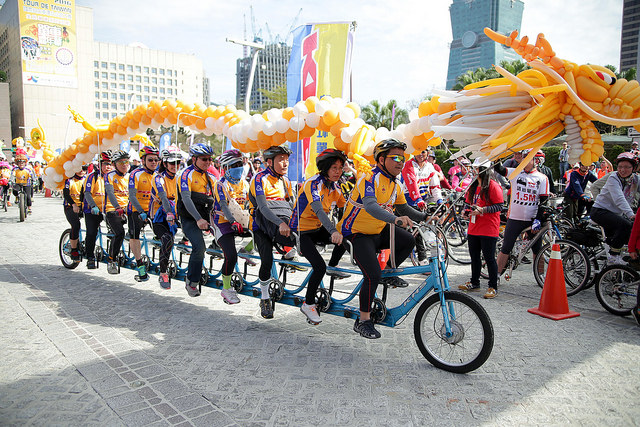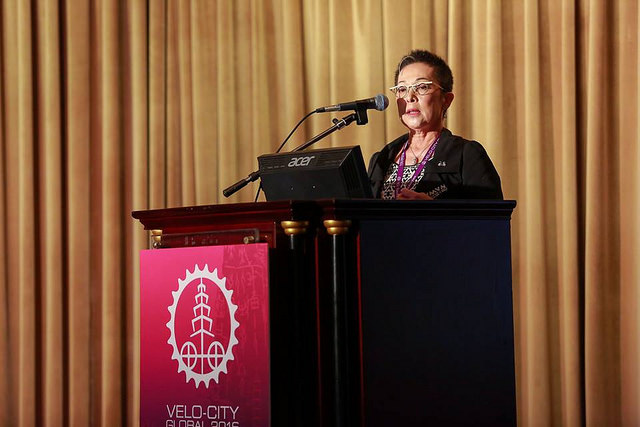VELO-CITY GLOBAL TAIPEI 2016 - DAY 02
28th of February
Smart Cycling and Cycling Smart: the Evolution of Everyday Life
Cycling Smart, a Way of Life
 Featuring inspiring presentations from different world regions, Velo-city Global Taipei’s second plenary "Cycling Smart, A Way of Life” looked into the future of cycling. Siddharth Pandit, Chair of CIDCO Smart City Lab Project at the National Institute of Urban Affairs (NIUA) in India, gave an introduction to Indian cycling culture and presented the country’s “Smart Cities Mission”, a US$ 14 billion urban renewal program of which sustainable mobility, including cycling, forms an integral part – an impressive budget commitment by the Indian government and an example on how to find a human-based approach to the concept “smart city”.
Featuring inspiring presentations from different world regions, Velo-city Global Taipei’s second plenary "Cycling Smart, A Way of Life” looked into the future of cycling. Siddharth Pandit, Chair of CIDCO Smart City Lab Project at the National Institute of Urban Affairs (NIUA) in India, gave an introduction to Indian cycling culture and presented the country’s “Smart Cities Mission”, a US$ 14 billion urban renewal program of which sustainable mobility, including cycling, forms an integral part – an impressive budget commitment by the Indian government and an example on how to find a human-based approach to the concept “smart city”.
In contrast to this holistic view, the European Commission does not yet include cycling in its smart city funding programmes. Kevin Mayne, Development Director at the European Cyclists’ Federation, called upon cycling advocates and policy makers to become part of the smart cities movement, because the decisions that are currently taken in this field will influence the future of mobility for the next decades: “We need to redefine smart city in human terms”.
A concrete example of how bikes can become smarter was presented by Hiroki Ohwada, Vice Chairman of Broad Band Tower, a Japanese company that develops sensors and data collection systems for “smart bikes”. These sensors can for example help you to identify your bike at large bike parkings. Besides this business activity, Hiroki also produced the movie “Riding Breeze”, a Japanese-Taiwanese co-production revolving around a couple falling in love during a bike tour in Taiwan. For him, both activities are complementary, since new technologies also serve for creating connections between humans.
In his final presentation, Klaus Bondam, CEO of the Danish Cyclists’ Federation (DCF), showed how cycling advocacy can become part of the “sharing society” by forming cross-sectorial coalitions and achieving collective impact. For example, in Denmark the successful collaboration between DCF, public authorities, freight transport associations and the road safety agency has led to a significant decrease in right-turn accidents where cyclists are killed or severely injured by lorries. Bondam concluded:
This cross-sectorial collaboration can lead to unexpected results, for example the freight transport association is now sponsoring the Bike to Work programme
Bike Parade! The Ultimate Proof of the Power Cycling could Unleash
About 5,000 cyclists from all corners of the world got on their bikes today to enjoy an exclusive bike ride through the Velo-city host city of Taipei. A very large number of local Taipei cyclists of all ages joined the velo-city conference delegation. Everyone fully enjoyed the sun and the privilege to have Taipei's large boulevard reserved for leisure cycling. Oh, if everyday could be like that!
The city government prepared a beautiful route underneath palmées, over a closed section of the highway and last but not least along the scenic river. A million pictures were taken by people watching the cycling crowd pass by and by the cyclists themselves. The ride ended with a joyful festival in front of the city hall.
These are just few of the pictures: check our Velo-city gallery!




Searching for a Cookbook for the Perfect Bike Sharing System? Search no More

Smart Bike Sharing, Sustainable Mobility
The managers of the greatest Public Bike Sharing (PBS) systems in the world gathered today to share their recommendations and experiences about the key steps to take for the development and implementation of a successful PBS.
Vicky Yang of Giant was the first speaker. As CEO of Taipei’s PBS, she considers Youbike to be ahead of the game, since it has the highest turnover per day per bike of any other PBS:
Good bikes, good redistribution and good apps to assist the user in finding the bikes and finding their way around their account and registration are my recommendations

This particular system has had an excellent cooperation between local government and the private sector in the shape of Giant bike manufacturers, and there have been good results in the growth of the bike system but has also helped feed the modal shift away from passive polluting transport. It’s remarkable that 31.2% of Youbikers switched from motorbikes and 4.4% from cars.
Transport for London is London’s huge PBS, which currently runs about 11,500 bikes and 19,000 docking points. David Eddington, who runs it, shared the key problem for his system: the redistribution of the bikes, particularly at rush hour from around the main railway stations. He concluded with a laugh: “I am probably the only Londoner who enjoys a tube strike, as it boosts my cycling numbers!”
Barcelona’s Bicing system, about half the size of London’s, has seen a slight drop in numbers from around 40% in 2012 to around 32% now. Redha Zetchi, Bicing’s manager, attributes these numbers to a shift to private bike use of 29% over that time. “This is another excellent use of Public Bike Share as not only an efficient transport mode in its own right” added Zetchi “but also as a great way to tempt people onto bikes without the barriers of cost, storage, theft, and so on.” His suggestions are similar to those VIcky shared:
Simplicity of use; good fares and information integration; good cycling infrastructure in general; good coverage
The southern Taiwanese town of Kaohsiung has a smaller PBS of around 2,400 bikes, and Chiu Mu-Hsin, the General Manager of Traffic Operations, stated that one of the main reasons of the system is to provide a link to the subway and buses. This creation of a multi-modal network has managed to solve the last mile issue for public transport in the city, and has been based on interaction with other public transport modes: it has grown from being a predominantly leisure type of activity to a fully blown everyday transport mode in its own right.
Different Ways to Travel for Different Travellers: the Evolution of Tourism
Investing in Different Ways to Travel
The sub-plenary “Investing in different ways to travel“ featured presentations on the economic benefits of cycle tourism as well as different innovative cycle tourism projects in Taiwan and Japan.
 According to numbers presented by Adam Bodor, Director for Advocacy and Eurovelo at the European Cyclists’ Federation, bike tourism is now creating more turnover than cruise tourism in Europe, and at the same time helping SMEs, creating local employment and tax incomes, and reducing CO2 emissions. Among the factors for this success, he cited good connectivity to public transport, attractive routes with a coherent signalisation system – including the European EuroVelo routes – a comprehensive offer of services along the route, as well as good promotion and marketing tools.
According to numbers presented by Adam Bodor, Director for Advocacy and Eurovelo at the European Cyclists’ Federation, bike tourism is now creating more turnover than cruise tourism in Europe, and at the same time helping SMEs, creating local employment and tax incomes, and reducing CO2 emissions. Among the factors for this success, he cited good connectivity to public transport, attractive routes with a coherent signalisation system – including the European EuroVelo routes – a comprehensive offer of services along the route, as well as good promotion and marketing tools.
The three East Asian projects presented afterwards fulfilled all of these criteria. For example, the cycle tourism strategy of Bibai City on the Japanese island of Hokkaido (presented by Mayor Mikio Takahashi), has created unique sightseeing routes covering wide areas around the city. On the Taiwan cycling route, presented by Chih-Ku Fan, Administrative Deputy Minister at the Ministry of Transportation and Communications of Taiwan, cyclists can enjoy refreshments and bike services at 122 supply stations and they can take their bikes on and off trains at 11 connecting stations. Finally, the Lake Hanza Cycling network presented by Satoru Hoshino, Deputy Mayor of Hamamatsu City is located in a beautiful hot springs area, allows for cycling all year round and is connected to boat transport on the lake.
The Quality of Life is Generally Improving: What Part do Bicycles Play in This?
Cycling for Quality of Life
As well as its focus on transport and tourism the Velo-city conference series always tries to advance the supporting arguments for cycling in public policy. One of the most important themes for doing that are the health benefits and once again Velo-city delivered a high quality health session called “Cycling for Quality of Life”.
 This session blended expert international experience from Nick Cavill, Director of Cavill Associates, with the aspirations of the Taiwanese Health Promotion Administration and the Taiwanese Bicycle Industry’s “Cycling and Health Technology Research and Development Center” (CHT), the only one of its kind in the world.
This session blended expert international experience from Nick Cavill, Director of Cavill Associates, with the aspirations of the Taiwanese Health Promotion Administration and the Taiwanese Bicycle Industry’s “Cycling and Health Technology Research and Development Center” (CHT), the only one of its kind in the world.
Both Nick and Shu-ti Chiou, Director General of the agency showed the societal value of reduced mortality that results from physical activity through regular walking or cycling, which have become an important element of public health policy in Taiwan. Cavill also mentioned the Turn up the HEAT, a publication issued by ECF about the HEAT (Health Economic Assessment Tool), an effective instrument to estimate health economic benefits; Cavill was also one of the main contributors to that report.
Robert Wu, Chairman of CHT showed a complete range of practical implementations for those policies being supported by research and pilots funded by the bicycle industry from safer bicycle designs to supporting new cycling infrastructure. He made it very clear that he saw it as a form of advocacy, a duty on the industry to contribute to life and health.
A great quote from Nick Cavill summed up the whole session:
I don’t ride my bicycle to add days to my life, but to add life to my days
